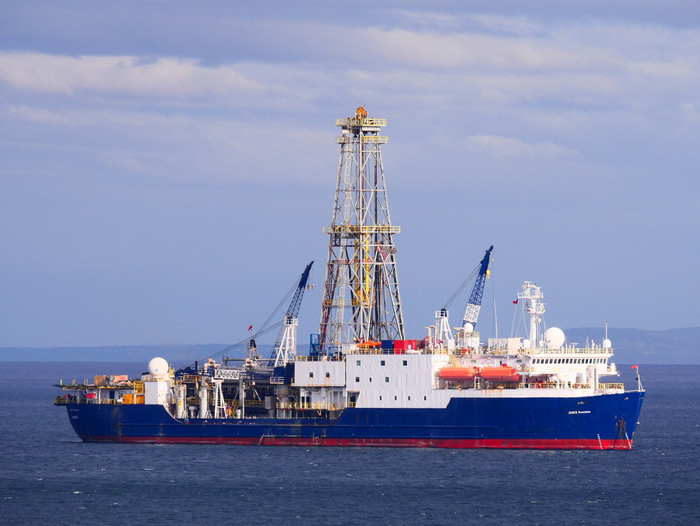Changes in the concentration of atmospheric carbon dioxide (CO2) are considered to be the main cause of past and future climate change. A long-standing debate centers on whether the roughly 30 percent lower CO2 content of the ice-age atmosphere was caused by iron fertilization. It is argued that iron-rich dust is carried into the ocean by wind and water, where it stimulates the growth of algae that absorb more CO2. As the algae die and then sink permanently into the depths of the ocean, the CO2 also remains there like in a trap. Although there is clear evidence that dust input increased during the ice ages, the fertilization effect is controversial, at least for the Antarctic Ocean.

Credit: IODP
Changes in the concentration of atmospheric carbon dioxide (CO2) are considered to be the main cause of past and future climate change. A long-standing debate centers on whether the roughly 30 percent lower CO2 content of the ice-age atmosphere was caused by iron fertilization. It is argued that iron-rich dust is carried into the ocean by wind and water, where it stimulates the growth of algae that absorb more CO2. As the algae die and then sink permanently into the depths of the ocean, the CO2 also remains there like in a trap. Although there is clear evidence that dust input increased during the ice ages, the fertilization effect is controversial, at least for the Antarctic Ocean.
In a recent study, an international team of 38 researchers from 13 countries led by Dr. Michael Weber from the Institute for Geosciences at the University of Bonn investigated this question. As part of the Integrated Ocean Discovery Program (IODP), the team traveled to the Scotia Sea on the drillship “JOIDES Resolution” and spent two months in 2019 bringing up cores from the seafloor at depths of 3,000 to 4,000 meters. Weber: “We collected the highest-resolution and longest climate archive ever obtained near Antarctica and its main dust source, Patagonia.”
1.5 million years of climate history
In the 200-meter-long deep-sea core U1537, the climate history of the last 1.5 million years was recorded in detail. This allows the reconstruction of the dust input to be nearly doubled, since Antarctic ice cores only cover the last 800,000 years. Current records from the deep ocean show that dust deposition during the ice ages was actually five to 15 times higher. This is also reflected in the ice cores.
However, the researchers found no evidence of a fertilization effect from dust in the Antarctic Ocean during the ice ages. Rather, the production of algae, for example, and thus carbon CO2 sequestration, was high only during warm periods when dust input into the Scotia Sea was low. This means that during cold periods, other processes prevented the CO2 captured in the ocean from escaping into the atmosphere and triggering warming. The main factors here are much more extensive sea ice cover, more intense stratification in the ocean, and reduced dynamics of the current systems, which contributed to a reduction in the CO2 content of the atmosphere during cold periods.
The opposing trends in dust deposition and oceanic productivity during the ice ages and interglacial periods of the Pleistocene are accompanied by long-term, gradual changes in the climate system in the southern polar region. Bioproductivity was particularly high during the interglacial periods of the last 400,000 years, but during the mid-Pleistocene transition 1.2 million to 700,000 years ago, it differed little from that during cold periods. As the transition progressed, the dust input covered larger and larger areas in the Southern Hemisphere. Abrupt changes continued to occur 900,000 years ago, indicating greater glaciation of Antarctica.
“There is indeed evidence of a fertilization effect during the ice ages in cores outside the Antarctic zone,” Weber concludes. “However, our study shows that atmospheric CO2 fluctuations do not depend solely on iron fertilization from dust deposition. In the Antarctic Ocean, it is rather a complex interplay of a westerly wind system, productivity, and feedback with sea ice. This relationship has been consistent over the last 1.5 million years.”
Publication: Weber, M.E., Bailey, I., Reilly, Hemming, S., Martos, Y.M., Reilly, B.T., Ronge, T., Brachfeld, S., Williams, T., Raymo, M.E., Belt, S.T., Smik, L., Vogel, H., Peck, V., Armbrecht, L., Cage, A., Cardillo, F.G., Du, Z., Fauth, G., Fogwill, C.J., Garcia, M., Garnsworthy, M., Glueder, A., Guitard, M., Gutjahr, M., Hernandez-Almeida, I., Hoem, F., Hwang, J.-H., Iizuka, M., Kato, Y., Lee, B.,O’Connell, S., Pérez, L.F., Seki, O., Stevens, L., Tauxe, L., Tripathi, S., Warnock, J., and Zheng, X.: Antiphased dust deposition and productivity in the Antarctic Zone over the past 1.5 Ma. Nature Communications, DOI: https://doi.org/10.1038/s41467-022-29642-5.
Journal
Nature Communications
DOI
10.1038/s41467-022-29642-5
Article Title
Antiphased dust deposition and productivity in the Antarctic Zone over the past 1.5 Ma
Article Publication Date
19-Apr-2022




